Brand messaging that gets results 🔗
Stories have the unique power to connect people, and that connection can foster a relationship that transcends transactions. Great stories — the ones we revere and remember — center on authenticity. A real story is more powerful than you think. We forge connections with people who proudly wear their honesty, vulnerability, and integrity.
Consumers want to know who you are and what you stand for. Are you the brand that cares about sustainability and zero waste? Are you centered on making sure you value your employees as much as your customers? Move past what your product or services offer a consumer and tell them how it makes them feel and how they can be part of the story.
Serendipity is how your business launched as a result of a coincidence, accident, or the lucky stars. Specificity adds value. Use specific images, words, and cultural signifiers that your customer can relate to and understand.
When crafting your narrative, it’s important to establish a cohesive, clear, and compelling strategy for creating and sharing your stories. A content strategy is a structured plan where you create content, promote it, test, learn, and optimize results.
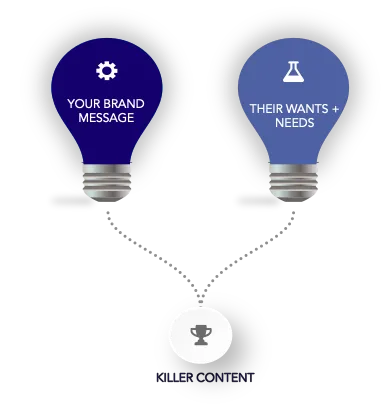
When marketing messages are merged with a consumers’ wants, needs, and preferences, the result is a compelling content strategy. Your marketing messages are composed of your positioning and purpose, elevator and signature story, and brand benefits and reason to believe. They’re the core communication elements of your brand and your personality, voice, tone, and content strategy give it life. Striking a balance between them is vital because if your content strategy resembles a child screeching “Buy me!” on volume level 10, your customers will run screaming. Conversely, if your content ignores all your brand fundamentals, you won’t effectively communicate who you are, what you do, and why you matter. The confluence of message and customer are a symphony every marketer has to compose.
While your customer cares about the quality and efficacy of the services they’re buying, they remember their experience with a brand above all else. Humans are irrational; we feel first and think second. Consumers expect that their experience will be personalized, relevant, valuable, and memorable. While your sales strategy and marketing plan will define how you achieve this, a smart content strategy plays a key role.
Content has to straddle both the rational and the emotional and ladder back to your marketing messaging and brand benefits. If you focus on giving people only the content they want and need, when and where they need it, you’ll stand apart from the pack. Your content should shift beyond what your brand does to how it makes people feel.
Before you start designing your content strategy, snapping photos, and crafting clever captions, give serious and considerable thought to these six questions:
Do you know your objectives? 🔗
Every customer goes through various stages of making a decision. A need or desire triggers an action. They begin to search for options. As a marketer, you want to execute strategies that drive awareness, i.e., get your brand on your prospects’ radar. Once someone finds a few different options that would potentially solve their want or need, they begin the evaluation process to determine which option makes the cut. During this time, they may sign up for your newsletter or follow you on social media before committing to a purchase. For marketers, this is a critical point of contact because they’re on display, and they’ll make sure their customer has all the evidence they need to make an informed decision. Then, the person makes a purchase decision, and if their experience with the product and service is favorable, they’ll likely buy from you again and become a brand evangelist.
If your objective is singular — increase revenue — you’re leaving a lot on the table. You don’t make products, snap your fingers, and poof, there’s your customer with cash in hand. When a prospective guest needs a product or service, they’re making informed choices each step of the way in evaluating which brand gets their dollars and affection. In order to effectively increase revenue, you have to be present in all phases of their journey, from the search phase to post-purchase.
Some of your objectives could be:
- Create the perception that your brand is the only brand that offers [customer benefit], or your brand offers the best [customer benefit] for [type of customer].
- Drive incremental newsletter subscribers to segment them and provide relevant targeted offers.
- Encourage and reward customers for telling their stories because social proof is powerfully influential.
- Create awareness for new product launches.
- Define objectives that will impact the health of your brand and the growth of your business in the short and long term.
Do you have a solid brand platform? 🔗
Imagine throwing your first dinner party in the house you’ve built by watching YouTube videos. You roll out the fine china and fancy stemware. You light fragrant candles while your roast is in the oven. One by one your guests file in, only to fall into the earth below because you have no floors. A storm starts to assail and you’re all soaked, the candles flare out, and the roast is soggy because you neglected to build a roof. It occurs to you that you missed the first video in the house-building series, which focused on creating a blueprint.
Consider your brand platform the blueprint for your house. You need it so you can host a party without having to wheel your friends to the ER. The blueprint lays the foundation for the stories you tell and how and to whom you tell them. So before you start building your storytelling strategy, make sure you’ve shored up your brand essentials. Your brand platform is your guideline for ensuring that you’re communicating how and why you’re special and unique in the eyes of your customer. It also guides the story decisions you make to ensure you’re making it clear why someone should choose you.
- Mission describes the purpose of your organization and how you’ll achieve that purpose.
- Vision is an aspirational statement that outlines your long-term objectives and goals over time.
- Positioning and purpose can be defined as the territory you occupy in your customer’s mind relative to your competitors and whether customers believe you’re the best option to meet their needs.
- Brand benefits are the tangible and intangible values (rational — or functional — and emotional) that your customer experiences as a result of using your product or service. Your reason to believe (RTB) is, simply put, why your customer should believe you.
- Brand personality, voice, and tone refer to the human characteristics, emotions, and attributes embodied by a brand. Your personality is composed of your tone of voice — all the elements that make an individual unique and establish their identity. Voice and tone are the expression and embodiment of your personality, beliefs, and values.
Do you know your customers? 🔗
Do you cater to billionaires or families on a budget? Your storytelling strategy should center on the customer based on their interests, behaviors, habits, motivations, influences, lifestyles, wants, needs, and preferences. It’s important to develop a comprehensive profile of your customer, along with their journey to your brand, so you can create stories that will inspire and motivate them to buy into your promise.
A customer journey is precisely what it sounds like: your prospects’ path to you. You’re starting from the point when they’ve been victimized to their outcome and end state. Then you map what they feel, need, and want along the way — how you can meet and surpass each step in the journey with your marketing, messaging, and expertise. Journey maps include:
- A flowchart or diagrammatic representation of the journey clients take
- All interactions and interfaces (touchpoints) between the prospect and your brand
- Likely pain points in the journey, i.e., areas where the customer is expected to experience difficulties or negative emotions and how you can solve for them
- What they feel, think, do, hear, and see throughout the process that’s pertinent to your marketing and messaging
- Key moments of truth, i.e., areas where there is the opportunity to make or break the relationship
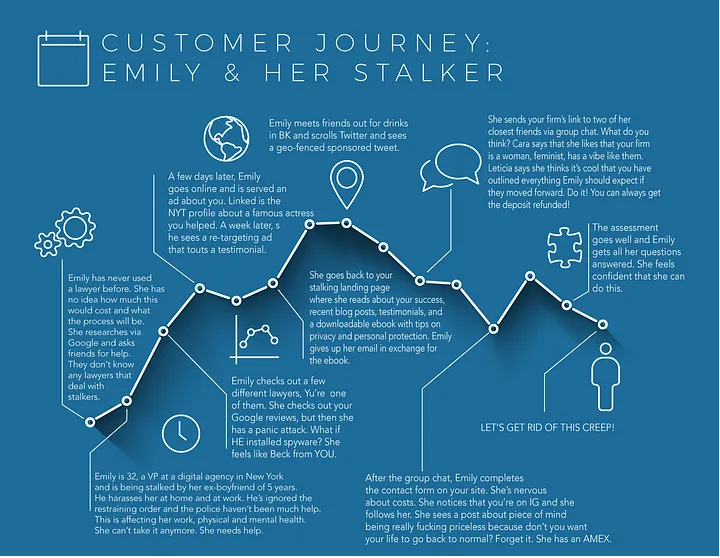
It’s entirely possible that your brand may appeal to several different kinds of people and that you’ll have to create different journey maps. That’s why it’s essential to build distinct profiles of the kinds of people you want to attract based on your brand and products. Then, you can devise a content strategy that satisfies the needs of the segments and the channels where they reside.
It takes time to earn your prospects’ trust. They may not immediately see or care about your message, so be patient. Understand their journey and all the circuitous routes it may take and make sure you’re part of that trip every step of the way.
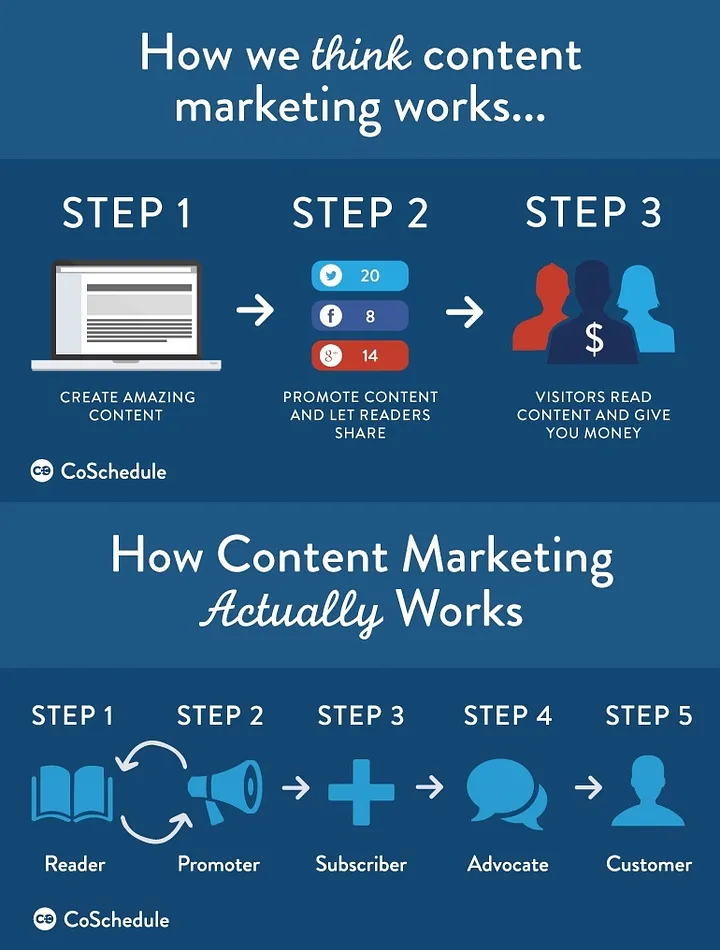
Do you know what your customers care about? 🔗
Smart marketing starts and ends with data. Data gives you vital insights about your ideal customer, and it also communicates whether your marketing strategies targeting that customer are efficient and effective. When creating a storytelling strategy, you have to focus on the kind of content they want to consume, which would influence their decision-making rather than what you, as a brand, want to publish because you’re not the one buying your products.
Use data to understand their lifestyle, needs, and preferences. Discover the kinds of conversations they’re having online about you and your competitors. Focus on the questions they’re asking, the content they engage with, and the reviews they leave online.
Let’s say you’re in the hospitality business. If you’re targeting families, you may want to showcase images and videos relating to the kid-friendly aspects of your property, such as family tours and excursions, kids’ menus, childcare centers, and high chairs. Showcase family fun as well as some adult time while the kids are frolicking in daycare. Maybe you want to highlight the in-room amenities (e.g., playpens and cribs) so guests know that their every need has been considered and taken care of.
Do you know what channels they’re on? 🔗
Gone are the days when you crafted beautiful sites and stories and people would naturally flock to you. When a prospect wants to buy a product or service, your website isn’t the first place they’ll visit when they start looking. They may start their search on Google or visit Instagram or Amazon — the possibilities are based on your customer and their needs, wants, and preferences and are seemingly endless. Now you have to consider your content in the context of its distribution. It’s incumbent on you to find your customers and play on the channels where they are.
Consumers are bombarded with over 10,000 marketing messages a day — from the labels on their clothes and cereal packaging to the billboards they pass on the way to work — so they’ll need to be ”touched” quite a few times, in different locations, before they consider your brand. Customers expect emotional connections from brands. Not only does your storytelling have to attract them, but it also has to make them feel something about your brand.
Become a CIA operative when it comes to learning about your customer. Where do they get their information or inspiration from, and who or what influences their purchase decisions? Are they on Instagram and Pinterest or scrolling through Reddit forums — or all of the above? Learn about the media they consume (e.g., websites, social networks, newsletters, magazines, TV shows, podcasts, etc. ) and connect and communicate with your customer on their preferred networks — directly through content and engagement or indirectly via ad targeting and remarketing.
Do you have the resources to bring your story to the masses? 🔗
Now that you’ve laid the foundation for your brand and learned everything you need to know about your customer, you’re ready to start crafting stories. But first, you need to be honest with yourself about your resources because you want to be effective and efficient. If you’re going to make the effort, you might as well be realistic about the tools in your arsenal and when and how you can use them. If you don’t have the budget to create videos, don’t create videos. Focus on the resources you have and the ways you can create and distribute compelling stories.
Ask these questions:
- What resources do you have? Even if you’re scrappy with access to free online tools and applications, you’ll still need staff (even if it’s a team of two with a camera and a dream) and a budget to plan, create, execute, monitor, and manage the stories you create. You’ll either need a dedicated team or people who can allocate a portion of their week to uninterrupted storytelling. You’ll need to identify the tools you need to create, publish, and mobilize those stories (e.g., tools like Canva, Photoshop, Crello, Hootsuite, Planoly, Trello, etc.) and to determine the social listening and online analytics platforms you’ll need to measure success.
- How much of your resources can be allocated and when? The worst-case scenario is having a lot of ambition but then failing epically in the follow-through. You’ve seen it before: the brand that posts the same stock photo content on every channel with generic copy and rampant promotional messages. It just ends up looking like spam. That’s a brand that shouts at their customers, instead of taking the time to meaningfully engage with them. The brand that never answers inquiries and ends up copying content from standout brands. The brand no one follows unless it’s for a freebie. Know that it’s better to prioritize your resources in relation to your tactics so you can start small and make your mark instead of overreaching. The channels will always be there and you don’t have to be everywhere all at once; you just have to be remarkable on the channels where you operate.
Powerful and effective brand storytelling isn’t about waking up in the morning with hope that content inspiration will strike. Like all other aspects of your business, storytelling isn’t a ramshackle, haphazard act. Rather, it’s a methodical plan to develop, distribute, and optimize your message for your ideal customer. Your content strategy is designed to be in-step with them throughout their entire journey with your brand so that you can ultimately cultivate meaningful relationships and drive business results.
The following content strategy framework is useful because it starts, ends, and remains consistently informed by data and insights in three steps:
- content creation
- content distribution
- content management and measurement
The key here is making sure you have a product or service people care about.
In marketing, there’s a joke that sometimes our job is reduced to “throwing glitter on shit” because that’s what it feels like when you’re tasked with promoting a product you know isn’t any good. It took me years to learn that if the product isn’t good, no amount of content marketing will save it.
Step 1: Content creation 🔗
In this step, you’re defining the message, the creator of the message, and the intended audience. Content is only powerful in the context of its distribution and should have no dead ends. Every story you publish has to include a CTA (call to action) inviting fans and followers to immerse in your brand. Never leave a customer wondering what to do next; always give them options and lead them along the way.
Story steps 🔗
All stories start and end with your customer and align with their journey to your brand. You start with their trigger, their motivation to act, and you end with their result and benefit. Each step in their journey also ladders to your business and brand objectives.
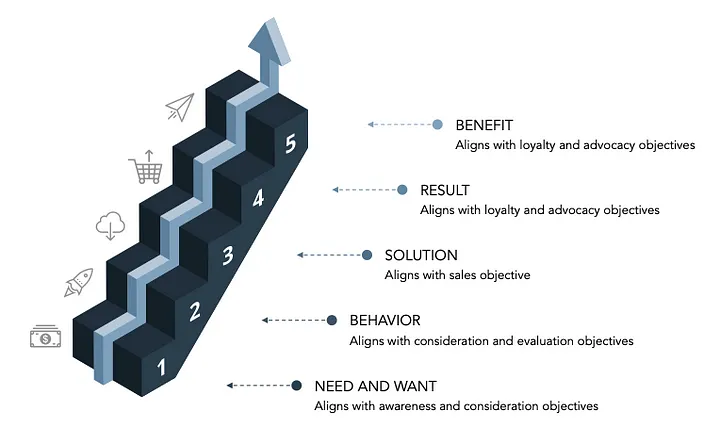
- Need: What motivates your customer to act? What kinds of content could you create in their hunting and gathering stage, and where should this content ideally be distributed?
- Want: What is their ideal outcome? How do they want to think and feel? How can you create content that identifies this want and speaks to them directly? Can you define who or what influencers their decision-making and leverage that as part of your content mix? Can you use testimonials, influencers, and social proof to validate their feelings and how your brand can serve them?
- Behavior: How and where do they buy? How can you make this process seamless for them in the content you create and where it’s syndicated?
- Solution: Reintegrate and drive home your solution and why you’re the only brand who can solve their dilemma. Lean into your positioning, brand and product benefit, and reason to believe messaging. How can you drive that home in the critical buy moment?
- Result: What will be the outcome of their purchase or engagement with your brand or products? What will they experience?
- Benefit: How will they feel as a result of their purchase and between points of purchase?
Use your customer journey in this exercise and determine what stories and supporting marketing tactics you can use to create and share your message when your audience needs it most.
Let your content serve as the gateway drug to your brand. Lure them in with stories they crave so you can cultivate a relationship and build trust by demonstrating why you’re the only solution for their wants and needs.
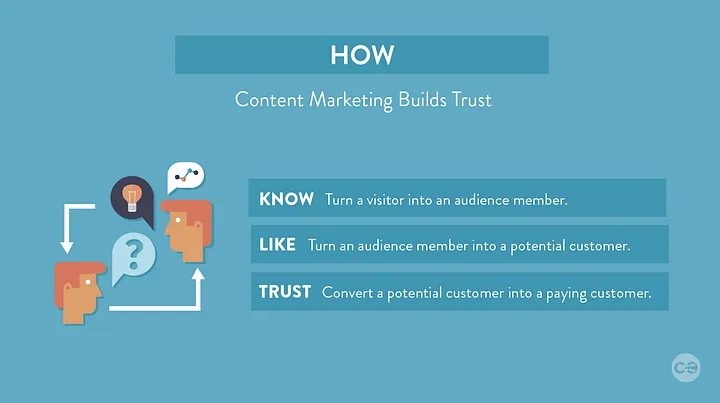
Content pillars 🔗
Every brand has its own story waiting to be told, and you have the opportunity to convey what makes your brand unique. Map out three to five themes that effectively communicate your brand’s positioning, promise, purpose, and values. Pillars create story continuity and reinforce your brand as specific and distinctive. They also provide helpful guardrails for composing content and give visual and strategic direction. Consumers crave consistency; they want to be reminded of what makes you stand out. How do you create story pillars?
- Know your audience. Broken record here, but everything in marketing harkens back to your customer. What are their wants, needs, preferences, behaviors, motivations, pain points, influences, and habits?
- What are your customers talking about on your online channels and off-channel? Look through questions that come from your customers throughout their entire journey, from their research and evaluation phase to post-purchase. Are there common questions and themes that can be transformed into pillars? Stick around for offline events and online Q&As. What are people talking about? What questions are they asking? What wants, needs, and problems are they expressing? Read, respond, and ask questions in your blog and social media posts. Check out what’s going on with social media, and use it to ask your audience questions. Read reviews they’ve left for you and your competitors. What questions are they asking and what are they looking for? Also, ask your audience directly. You can do this informally via an email marketing campaign or formally with incentivized surveys; both will grant you access to the kinds of content and experiences they crave.
- What are the top influencers in your community talking about? Find the top influencers who understand what you’re offering and can relate to it on an intuitive level. Follow them. You can use a service like BuzzSumo for discovery. Analyze what they’re talking about and create content that naturally integrates you into the dialogue.
- What types of content are they clamoring for and who do they want to hear from? Does your audience want how-to guides or stylized images? Do they crave infographics or podcasts? Do they connect with a demonstration or live video? Do they want to hear from you, third-party experts, influencers, or celebs? Or maybe a mix of some or all of the above? You not only have to understand what content they want but also the form they’re likely to consume it in. For example, if you’re a cosmetics brand, one of your pillars might be weekly how-to videos delivered by a YouTube influencer you’ve partnered with.
Content categories
A content strategy isn’t about rolling out of bed with random thoughts and constructing them into semicoherent posts or tweets without any planning, research, or consideration for your customer. Don’t do this — ever. You’re mapping out stories people already know or care about over a period of time. Everything you create has intention and purpose and makes your audience feel rewarded and part of your community. Once you’ve defined your content pillars, you want to consider how you program and structure your stories.
- Hero content: This is your major content play. You’ve dedicated considerable time and investment in its creation. Designed to drive widespread awareness and inspiration, hero content could relate to a big launch, a landmark brand or product event, a major PR announcement, or a new advertising campaign. You can utilize Google Trends’ Explore tool to gauge early buzz surrounding your launch or event. Core objective: Inspire.
- Hub content: This content speaks to the specific interests of your audience. Created to strengthen the customer relationship, hub content is timely and regularly published to inform your audience about how you can solve their dilemmas and field their questions. Examples of hub content include podcasts, press releases, live videos, social media, newsletters, and blog posts. Core objective: Connect.
- Hygiene content: This represents “pull” content where you’re trying to attract new people to your brand based on their search results. The objective is to give credible answers to your prospects’ questions and establish your company as an authority in a particular area or subject matter. This content is evergreen in nature and could include demonstration videos, expert Q&As, guides, and how-to posts. Use tools like Google Trends, BuzzSumo and your internal CRM (customer relationship management) and analytics to determine frequent searches. Core objective: Help.
Every story should have five components and a three-arc narrative. You open with an introduction, an initializing incident that drives the story into action; your customer is struggling to overcome a particular challenge or pain point (arc one). The incident intensifies, reflecting the height of the story’s tension because the hero has yet to find their solution (arc two). Finally, a resolution surfaces that outlines lessons learned or outcomes achieved (arc three). Brands will occupy the space between the climax and resolution with their products and services, their positioning, benefits, and reason to believe — making the case for themselves. Once the customer enters their happy place, the brand establishes a call to action, defining what should happen next, the path the reader should take.
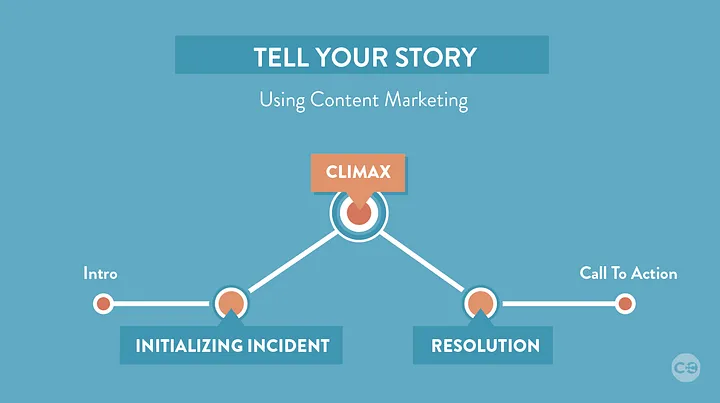
Content types 🔗
Let’s understand the various ways content can be produced, accessed, and used. You want a mix of content types.
- Owned: Created by the brand, it requires talented copywriting and a keen eye for visuals.
- Co-created: This content is created with a partner or influencer. You can either hire people to create content specifically for your channels or you can partner with brand-right influencers (e.g., bloggers, vloggers, photographers, tastemakers, etc.) to create content you can use. You can also repurpose content from any media coverage.
- Curated: Created by another brand or individual who doesn’t have an explicit relationship with your company, curated content is reposted with credit.
- Paid: Created by a third-party content provider, this content includes stock photography, vector images, videos, and GIFs purchased by the brand. Purchased images, used sparingly, can fill out your content calendar in a pinch.
Content filters 🔗
A multistage filtering process ensures the team only selects topics with the greatest potential for impact. The first two steps incorporate technology and human input to gather context around what might be the most interesting topics for clients. As a final step, the content marketing team eliminates topics not aligned with your brand’s strategic objectives. Apply three filters:
- Buzz: Search and social tools help identify ideas already generating buzz and activity in the marketplace.
- Customer interest: Investigating the customer context around popular ideas helps identify the most popular storylines among key stakeholders.
- Strategic alignment: Eliminating ideas not in line with your strategic objectives helps select the topics most likely to gain traction and benefit the brand, business, product lines, etc.
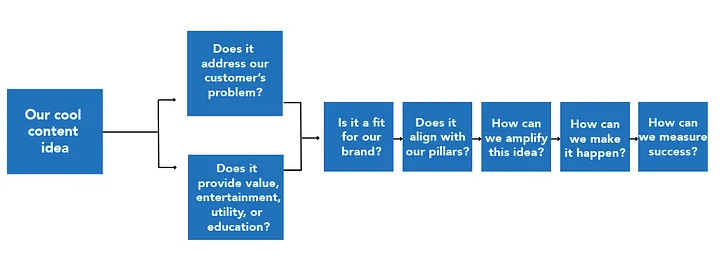
Step 2: Content distribution 🔗
In this step, you’re defining the best platform for your message and how to promote it.
Consider the channels 🔗
Think of “channels” as all the possible locations you could distribute your message. Examples can include newsletters, websites, social media, distribution and retail partners, advertisements, billboards, and in-store displays. There are four channel types:
- Owned: properties over which the brand has complete dominion and control. These are your retail locations, websites, social media, newsletters, direct mail collateral, brochures, etc.
- Earned: channels traditionally driven by PR and corporate communication and include online and print editorial coverage, TV and broadcast features, awards, and accreditations. Brands have little control over the message and perception apart from providing concrete facts.
- Paid: properties where a brand pays to disseminate their message. You’re paying for access to your audience and potential widespread visibility. While you have little control over the medium, you have complete control over the content of your message. Examples include PPC, display, print, OOH (out-of-home), and TV and radio spots, influencer marketing campaigns, celebrity endorsement deals, etc.
- Partner: outlets where a brand aligns with another brand in hopes of combining audiences for greater reach. Depending on the partnership, there could be a nonremunerative value exchange or it could be a compensation-based partnership based on who has more leverage and audience.
Now that you have an idea where you can place your message, let’s examine the location in the context of your ideal customer and the content you want to communicate.
Start with your customer journey, and evaluate each stage to determine what channels they would use to advance toward a resolution of their problem or concern. Identify the content you plan to map to each stage and then consider how to distribute the content on the channels where your user resides.
For example, let’s say you are an athletic apparel brand and you primarily sell high-end performance footwear geared toward women. Your customer cares about style, is physically fit, and doesn’t have a problem dropping $150 on a pair of sneakers. They’ve just worn through their current pair and are on the hunt for new ones. You can message and market to a particular customer throughout their brief journey to your brand.

Establish an integrated delivery plan 🔗
Because there are so many possible avenues in finding, attracting, and converting a prospect, you have to determine which distribution mechanisms will have the greatest return from a brand and business perspective based on your budget, resources, and brand platform.
Effective marketing functions like a symphony. Every instrument has its purpose, and masterful music couldn’t exist without the confluence and coordination of all the sounds the instruments make. Siloed marketing is expensive and ineffective. Instead, focus on a suite of content messages and tactics that have the best chance to impact your customer throughout their journey.
The confluence of tactics gives you a clear indication of what’s inefficient or broken. Your performance analytics will reveal the effectiveness and efficiency of each investment along the way and their impact on the next part of the journey.
Your objectives, customer profile, strategy, integrated tactics, and associated metrics are the foundation of your marketing plan. Your content strategy focuses on all aspects of creation, whereas distribution, management, and measurement fall under various groups within the marketing team.
Step 3: Content management and measurement 🔗
In this step, you’re defining how to manage and gauge the message’s impact. The smooth execution of a flawless content strategy is predicated on people, process, and technology. You need the right people in the right roles. You need tools to help them get the job, and you need technology to determine the success of the work.

Creating a lean, mean content team 🔗
Depending on your organization’s size and structure, there are myriad organizational models available: from the single decision approach that sets the strategic vision for a small content team, to varying levels of decentralized teams. The nimble centralized team creates strategically aligned, high-quality content by making effective use of their limited resources. The team will contract out copywriters, copy editors, designers, video editors, etc., as needed.
- Head of marketing: Manages strategy, content marketing, marketing automation, and demand generation.
- Content creator: Oversees content strategy with a focus on user and brand experience. This team creates the physical assets in-house and through contracted talent and SMEs (subject matter experts).
- Content manager: The team that publishes the content, manages the communities, feedback, and all technical aspects of social media, email, web, etc. This can also be a resource that manages your search and social media advertising efforts.
Process management 🔗
An effective content process map includes five key phases:
- Pre-planning: new content ideas are discussed and vetted, and brainstorming ensues.
- Planning and development: creative process kick-off, which includes creating a content map for the month laddering to objective(s), target audience and key message, channel, and timing, KPIs, and any outliers (i.e., legal approval, additional budget needs, etc.). As a result, the content calendar gets developed along with assignments for graphics and text creation.
- Distribution: distributes content across owned channels and manages any paid or partner syndication tactics
- Monitoring and management: dives into the community and ensures all questions are fielded (or escalated, if necessary) and that authentic, engaging conversations are occurring on the brand’s platforms.
- Measurement: analyzes content effectiveness against defined objectives and optimizes accordingly.
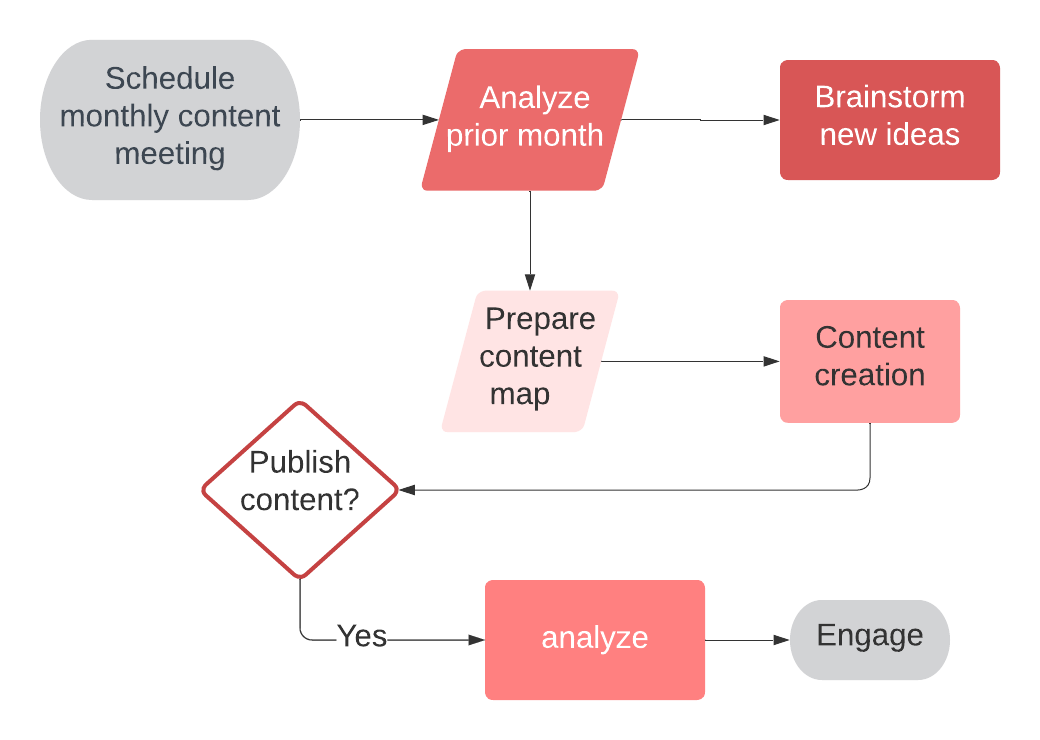
Guiding principles for creating content calendars 🔗
As a brand, you can develop content calendars on a weekly, monthly, or quarterly basis — whatever floats your boat. Monthly calendars are the norm for most companies because you have enough lead time to think strategically and enough room to craft timely, ephemeral stories.
Your team then meets to discuss and prioritize any key marketing messages and the cadence, frequency across your channels.
Be open and receptive to what types of content resonate. Also, give things time. No one makes material changes until after three months. Remember, your customers are slowly getting to know you — they don’t move as fast as you do! Let your message marinate.
While preplanned posts are necessary, you’re going to want to mix it up with ad-hoc content (e.g., Instagram stories, Facebook Live, Snaps on the go, etc.).
Content calendar components 🔗
When composing a calendar, you have to consider the macro view — the tent-pole campaigns, broad brand themes, and big events — juxtaposed with the micro view, which homes in on designing specific posts, by category, by channel.
Be sure to incorporate holidays, brand moments and celebrations, impact calendars, and events in your category, and cultural moments that are relevant to your brand and your customer. You want to be current.
There are free tools (e.g., MS Excel, Google Suite, Trello) that help you create, schedule, and analyze your content (which will give you insight into when to post and what types of content are working). My social media automation guide details all the tools and their pros and cons.
Content calendar creation 🔗
Now that you’ve solidified your brand platform, all the content creation essentials outlined in the first section, and have developed a process for calendar creation, execution, and management, you’re ready to build. Using Excel is easiest because you can mark discrete tabs for key quarterly, monthly, and daily messages. All your content is housed in one document and it’s easy to track and update. You can start to employ the 3H framework (hero, hub, hygiene) and all subsequent tools outlined in the first section.
You can also opt to use programs like CoSchedule to create calendars or a more sophisticated tools like Airtable or Sprout Social where you can merge your Excel spreadsheet with a live database.
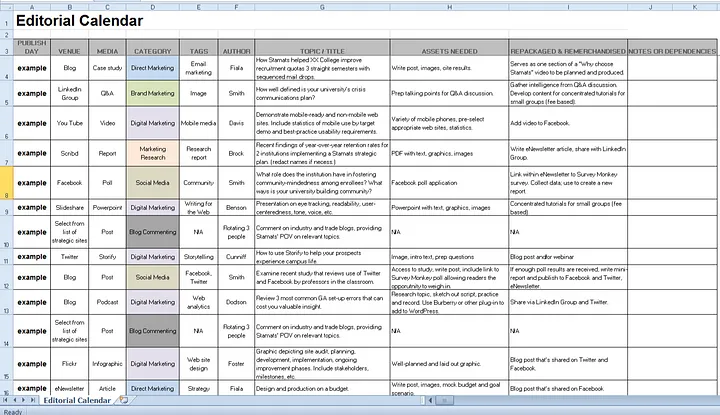
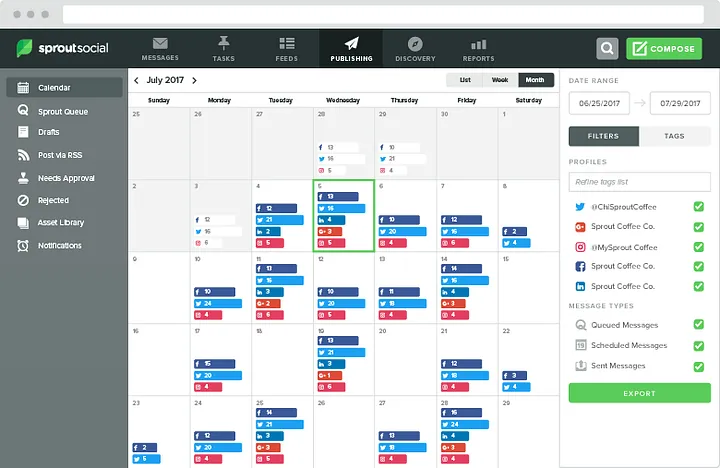

Content measurement 🔗
If it can’t be tracked in some way, it’s not worth creating. All the content you create should be analyzed by platform and in aggregate to determine what messages are working or falling short. While you want all roads to converge at the “buy button,” analyzing all your content across the user journey will help you tweak and optimize areas where you may need alternative or additional content.
You’ll also learn more about your audience — when and how they consume your content, the comments they leave, the friends they tag, and the number of shares. If you don’t have an enterprise listening tool like Sprout, Radian6, HubSpot, or Brandwatch, you can lean on your by-platform analytics. Most newsletter providers, like Mailchimp, ConvertKit, and InfusionSoft, offer a range of performance reports. For paid media, you’ll get analytics from your provider, and Google Analytics is still the gold standard for analyzing site traffic and performance.
Industry benchmarks for social, web, advertising, and email marketing are helpful, but they’re not gospel. Use them as a frame of reference, but establish your own path to success with monthly reviews and quarterly deep dives to analyze performance and refine your strategy, tactics, and KPIs accordingly.
Compelling, relatable, and memorable stories are more than a strategic device or a marketing tactic; they’re about forming lasting bonds between people. We connect through shared experiences, and our stories reveal our uniqueness, values, and vulnerability. The best stories are ones you can visualize in the retelling; you feel as if you’re there, experiencing the events firsthand. We immerse, we get involved, and we develop a relationship with the characters and story as they unfold. Your brand can be like a beloved book with a set of characters who embody vision, purpose, values, beliefs, and a reason for being.
Resources 🔗
- HubSpot has an excellent, comprehensive tutorial on creating customer journey maps.
- This smart, witty graphical representation compares the novice versus veteran content marketer.
- Harvard Business Review’s useful articles: “Your Content Marketing Strategy Doesn’t Have to Be Complicated” and “Why No One’s Reading Your Marketing Content”
- CoSchedule offers an essential 2019 content calendar template.
- Think With Google designed a YouTube playbook for brands.
- Google also offers free classes on digital and content marketing, as do HubSpot, CoSchedule, and Udemy.
- Brandpoint has a compelling infographic on content metrics.
- OptinMonster has a useful article on measuring content marketing ROI.



